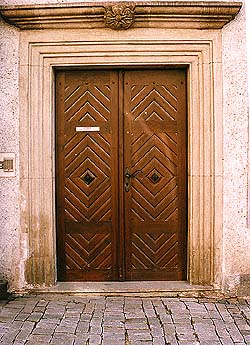Panská No. 18
Description of the Building:
A one-storey corner building with a Classical front originates from
the time about 1800 with some remains of the previous state. The
entrance portal is early-Gothic with a moulded cornice. It is a
deep two-aisle with barrel-vaults and an extensive hall at the
front.
Architectural and Historical Development:
The house originates from the 14th century. The cellar, originally
protruding above the terraine level, and a small pointed window in
the facade, facing Soukenická street, come from that time. The
layout of the ground floor including the vaults originates from the
late-Gothic period, from the beginning of the 16th century. The
early-Rennaissance portal and the decked ceiling on the first floor
are extremely important. The layout of the first floor belongs
among the most remarkable ones in Český Krumlov. It was probably
created in the Rennaissance period. In the second half of the 18th
century the house was reconstructed in two stages, in the Baroque
and Classical styles. The Baroque gable of the main front was
removed in 1894 together with the vaulting and a chimney cowl in
the scullery. In the first half of the 19th century the back wing
was added. The reconstruction was finished in 1987.
Significant Architectural Features:
An extremely significant Rennaissance portal ( first quarter of the
16th century ) with an engraved five-petal rose. A small pointed
window, facing Soukenická street, from the 14th century. The layout
of the first floor ( first third of the 16th century ).
History of the House Residents: In
the years 1459 - 1484 the owner of the house was a certain Zbiják.
This name was commonly used to call people of cooper´s trade. In
the years 1500 - 1504 the house belonged to Perml, who moved there
from Široká street. In 1510 a carpenter Marx moved in the house and
sold it then in 1525 to Michal Wostrštajgar, who got rid of it very
quickly, because in 1531 another owner, a shoemaker Havel, died
there. Shortly before his death, he sold the back part of the house
( called Kuglvajt, present Soukenická
No. 173) to a butcher Beneš. A furrier Michal came after him
and his wife Anna took the house over, when Michal died in 1536.
Anna died in 1549 and willed the house to her son Jeroným, who ran
furrier´s trade there further on. Jeroným, nicknamed Křivý Jaroš,
whose surname did not have to be the same as his father´s in that
time, could have been Hoslinger or Hofelhofer. Jaroš died in 1571
and left a widow Barbora with children. She sold the house in 1578
to a wood-carver Hans Marten, who died soon and the house was
bought from his widow Regina by a carpenter Prokop Weigl in 1588.
In 1605 Valentin Mazouch bought it and sold it to Petr Nucek in
1612. From 1621 his widow Kristina looked after the house and
handed it down to her son Ambrož. Ambrož sold the house to his
brother Michal in 1629 and he changed it with Jiří Schmidt ze
Schattenbergu for his house on the corner of the square and
Panská
No. 16 in 1638. In 1654 Schmidt´s widow Alžběta took care of
the house. The Schmidts ze Schattenbergu owned the house to the 50s
of the 18th century.
In
the years 1459 - 1484 the owner of the house was a certain Zbiják.
This name was commonly used to call people of cooper´s trade. In
the years 1500 - 1504 the house belonged to Perml, who moved there
from Široká street. In 1510 a carpenter Marx moved in the house and
sold it then in 1525 to Michal Wostrštajgar, who got rid of it very
quickly, because in 1531 another owner, a shoemaker Havel, died
there. Shortly before his death, he sold the back part of the house
( called Kuglvajt, present Soukenická
No. 173) to a butcher Beneš. A furrier Michal came after him
and his wife Anna took the house over, when Michal died in 1536.
Anna died in 1549 and willed the house to her son Jeroným, who ran
furrier´s trade there further on. Jeroným, nicknamed Křivý Jaroš,
whose surname did not have to be the same as his father´s in that
time, could have been Hoslinger or Hofelhofer. Jaroš died in 1571
and left a widow Barbora with children. She sold the house in 1578
to a wood-carver Hans Marten, who died soon and the house was
bought from his widow Regina by a carpenter Prokop Weigl in 1588.
In 1605 Valentin Mazouch bought it and sold it to Petr Nucek in
1612. From 1621 his widow Kristina looked after the house and
handed it down to her son Ambrož. Ambrož sold the house to his
brother Michal in 1629 and he changed it with Jiří Schmidt ze
Schattenbergu for his house on the corner of the square and
Panská
No. 16 in 1638. In 1654 Schmidt´s widow Alžběta took care of
the house. The Schmidts ze Schattenbergu owned the house to the 50s
of the 18th century.
Present Use:
India Restaurant - Taj Mahal


